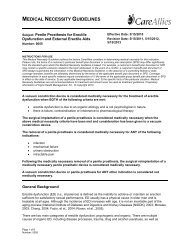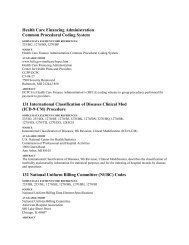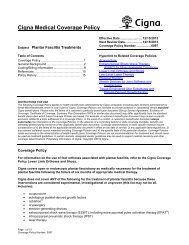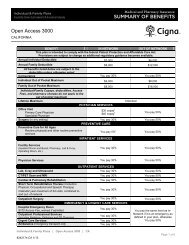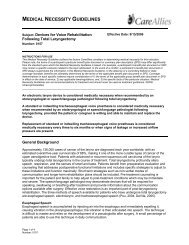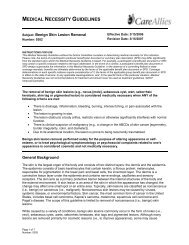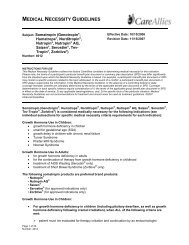Prophylactic Oophorectomy or Salpingo-oophorectomy With ... - Cigna
Prophylactic Oophorectomy or Salpingo-oophorectomy With ... - Cigna
Prophylactic Oophorectomy or Salpingo-oophorectomy With ... - Cigna
Create successful ePaper yourself
Turn your PDF publications into a flip-book with our unique Google optimized e-Paper software.
MEDICAL NECESSITY GUIDELINES<br />
Subject: <strong>Prophylactic</strong> <strong>Ooph<strong>or</strong>ectomy</strong> <strong>or</strong><br />
<strong>Salpingo</strong>-ooph<strong>or</strong>ectomy <strong>With</strong> <strong>or</strong><br />
<strong>With</strong>out Hysterectomy<br />
Number: 0026<br />
Effective Date: 2/15/2006<br />
Revision Date: 2/15/2007, 2/15/2008,<br />
2/15/2009, 2/15/2010, 2/15/2011,<br />
2/15/2012, 2/15/2013<br />
INSTRUCTIONS FOR USE<br />
This Medical Necessity Guideline outlines the fact<strong>or</strong>s CareAllies considers in determining medical necessity f<strong>or</strong> this indication.<br />
Please note, the terms of a customer’s particular benefit plan document <strong>or</strong> summary plan description (SPD) may differ significantly<br />
from the standard upon which this Medical Necessity Guideline is based. F<strong>or</strong> example, a customer’s benefit plan document <strong>or</strong> SPD<br />
may contain a specific exclusion related to the topic addressed. In the event of a conflict, a customer’s benefit plan document <strong>or</strong><br />
SPD always supercedes the inf<strong>or</strong>mation in this Medical Necessity Guideline. In the absence of a controlling federal <strong>or</strong> state<br />
coverage mandate, benefits are ultimately determined by the terms of the applicable benefit plan document <strong>or</strong> SPD. Coverage<br />
determinations in each specific instance require consideration of 1) the terms of the applicable group benefit plan document <strong>or</strong> SPD<br />
in effect on the date of service; 2) any applicable laws/regulations, and; 3) the specific facts of the particular situation. Medical<br />
Necessity Guidelines are not recommendations f<strong>or</strong> treatment and should never be used as treatment guidelines. Proprietary<br />
inf<strong>or</strong>mation of <strong>Cigna</strong> Health Management, Inc. © Copyright 2013.<br />
<strong>Prophylactic</strong> ooph<strong>or</strong>ectomy <strong>or</strong> salpingo-ooph<strong>or</strong>ectomy is considered medically necessary when<br />
ANY of the following criteria is met:<br />
• genetic mutation confirmed by molecular testing f<strong>or</strong> breast and ovarian cancer susceptibility<br />
genes (BRCA1 <strong>or</strong> BRCA2)<br />
• personal premenopausal hist<strong>or</strong>y of steroid h<strong>or</strong>mone recept<strong>or</strong>-positive breast cancer<br />
• personal hist<strong>or</strong>y of breast cancer and one first-degree* relative with a hist<strong>or</strong>y of ovarian cancer<br />
• two <strong>or</strong> m<strong>or</strong>e first-degree* relatives with early onset ovarian and/<strong>or</strong> breast cancer<br />
• known familial cancer syndrome associated with increased risk of ovarian cancer (e.g., hereditary<br />
nonpolyposis col<strong>or</strong>ectal cancer [HNPCC])<br />
*A first-degree relative is defined as a blood relative with whom an individual shares approximately 50%<br />
of his/her genes, including the individual's parents, full siblings, and children.<br />
<strong>Prophylactic</strong> hysterectomy is considered medically necessary when perf<strong>or</strong>med with bilateral<br />
ooph<strong>or</strong>ectomy f<strong>or</strong> those who have been diagnosed with HNPCC, found to be carriers of<br />
HNPCC─associated mutations, <strong>or</strong> are members of HNPCC families as determined by a pattern of<br />
occurrence of HNPCC-related cancers.<br />
General Background<br />
Ovarian cancer is the fifth leading cause of cancer death among women in the United States and has the<br />
highest m<strong>or</strong>tality rate of all gynecologic cancers. Ovarian and breast cancer are components of several<br />
inherited cancer syndromes including familial site-specific ovarian cancer; hereditary breast/ovarian<br />
cancer; and Lynch syndrome, which is a combination of breast, ovarian, endometrial, gastrointestinal, and<br />
genitourinary cancers. F<strong>or</strong> the general population of women, the lifetime risk of developing ovarian cancer<br />
is 1.39%; the lifetime risk of dying from ovarian cancer is 1.04%. Most hereditary breast and ovarian<br />
cancer are caused by inherited mutations in the BRCA1 <strong>or</strong> BRCA2 genes, which lead to lifetime risks of<br />
ovarian cancer of 20–50%. Considering family hist<strong>or</strong>y in the absence of specific inf<strong>or</strong>mation on BRCA1/2<br />
mutation status, unaffected women who have two <strong>or</strong> three relatives with ovarian cancer have a<br />
cumulative ovarian cancer risk of about 7%. Women who have a mother <strong>or</strong> sister with ovarian cancer<br />
have a cumulative lifetime risk of ovarian cancer of about 5%. (National Cancer Institute [NCI], 2011c).<br />
Women with a family hist<strong>or</strong>y of cancer of the breast, uterus, colon, <strong>or</strong> rectum may also have an increased<br />
Page 1 of 9<br />
Number: 0026
isk of ovarian cancer (NCI, 2006). Acc<strong>or</strong>ding to the NCI, Features of hereditary cancer include the<br />
following (NCI, 2012a):<br />
In the individual patient:<br />
• multiple primary tum<strong>or</strong>s in the same <strong>or</strong>gan<br />
• multiple primary tum<strong>or</strong>s in different <strong>or</strong>gans<br />
• bilateral primary tum<strong>or</strong>s in paired <strong>or</strong>gans<br />
• multifocality within a single <strong>or</strong>gan (e.g., multiple tum<strong>or</strong>s in the same breast all of which have risen<br />
from one <strong>or</strong>iginal tum<strong>or</strong>)<br />
• younger-than-usual age at tum<strong>or</strong> diagnosis<br />
• tum<strong>or</strong>s with rare histology<br />
• tum<strong>or</strong>s occurring in the sex not usually affected (e.g., breast cancer in men)<br />
• tum<strong>or</strong>s associated with other genetic traits; congenital defects; an inherited precurs<strong>or</strong> lesion; <strong>or</strong><br />
another rare disease;<br />
• tum<strong>or</strong>s associated with cutaneous lesions known to be related to cancer susceptibility dis<strong>or</strong>ders<br />
(e.g., the genodermatoses)<br />
In the patient’s family:<br />
• one first-degree relative with the same <strong>or</strong> a related tum<strong>or</strong> and one of the individual features listed<br />
• two <strong>or</strong> m<strong>or</strong>e first-degree relatives with tum<strong>or</strong>s of the same site<br />
• two <strong>or</strong> m<strong>or</strong>e first-degree relatives with tum<strong>or</strong> types belonging to a known familial cancer<br />
syndrome<br />
• two <strong>or</strong> m<strong>or</strong>e first-degree relatives with rare tum<strong>or</strong>s<br />
• three <strong>or</strong> m<strong>or</strong>e relatives in two generations with tum<strong>or</strong>s of the same site <strong>or</strong> etiologically related<br />
sites<br />
Clinical examination (i.e., bimanual pelvic examination) lacks the sensitivity needed to reliably identify<br />
early ovarian cancer, and there continues to be a lack of effective ovarian cancer detection methods.<br />
<strong>Prophylactic</strong> ooph<strong>or</strong>ectomy, the surgical removal of the ovaries, is a surgical option to reduce the risk of<br />
developing both ovarian and breast cancer in high-risk women (e.g., those with BRCA mutations, sitespecific<br />
ovarian cancer syndrome, <strong>or</strong> Lynch Syndrome). Although not technically the same, the term riskreducing<br />
salpingo-ooph<strong>or</strong>ectomy (RRSO), which includes removal of the ovaries and fallopian tubes, is<br />
used interchangeably with prophylactic ooph<strong>or</strong>ectomy. RRSO has been shown to reduce the risk of<br />
ovarian of ovarian cancer, fallopian tube cancer, and peritoneal cancer by approximately 85–90% in<br />
women with known mutations in BRCA1 <strong>or</strong> BRCA2. RRSO has been shown to decrease overall m<strong>or</strong>tality<br />
in women with a BRCA1 <strong>or</strong> BRCA2 mutation. The procedure has also been shown to reduce the risk of<br />
breast cancer by 40─70%. This protection likely occurs only if patients are premenopausal at the time of<br />
risk-reducing salpingo-ooph<strong>or</strong>ectomy (American College of Obstetricians and Gynecologists [ACOG],<br />
2009). The degree of risk f<strong>or</strong> ovarian <strong>or</strong> breast cancer, potential m<strong>or</strong>bidity and m<strong>or</strong>tality of surgery and the<br />
risks associated with early menopause should be taken into account when considering prophylactic<br />
ooph<strong>or</strong>ectomy f<strong>or</strong> high-risk women. Potential adverse effects of bilateral ooph<strong>or</strong>ectomy and premature<br />
menopause include vasomot<strong>or</strong> symptoms, cardiovascular disease, and osteop<strong>or</strong>osis (NCI, 2006).<br />
Literature Review<br />
Numerous studies have found that women at inherited risk of breast and ovarian cancer have a<br />
decreased risk of ovarian cancer following prophylactic ooph<strong>or</strong>ectomy. The available evidence evaluating<br />
the impact of prophylactic ooph<strong>or</strong>ectomy on individuals at high risk f<strong>or</strong> ovarian cancer includes systematic<br />
reviews, case-control and coh<strong>or</strong>t studies. Studies have primarily evaluated women with inherited<br />
mutations in BRCA1 <strong>or</strong> BRCA2. A systematic review (n=18 studies) by Bermejo-Pérez and colleagues<br />
(2007) assessed the effectiveness of preventive intervention strategies (i.e., prophylactic surgery,<br />
intensive cancer screening, and chemoprevention) implemented in women carrying mutations in BRCA1<br />
<strong>or</strong> BRCA2 genes, in terms of reducing breast and gynecological cancer incidence and/<strong>or</strong> m<strong>or</strong>tality.<br />
Although methodological flaws were identified in all the studies examined, overall, study results indicated<br />
that compared to surveillance, ooph<strong>or</strong>ectomy <strong>or</strong> salpingo-ooph<strong>or</strong>ectomy led to a reduction in breast<br />
cancer incidence in carriers of BRCA mutations (Bermejo-Pérez, et al., 2007).<br />
Page 2 of 9<br />
Number: 0026
Case-control and coh<strong>or</strong>t studies (n=170─1828) with median follow-up through 25 years have<br />
demonstrated that prophylactic ooph<strong>or</strong>ectomy is associated with a significant reduction in the risk of both<br />
ovarian and breast cancer (Domchek, et al., 2006; Finch, et al.; 2006; Rocca, et al., 2006; Rebbeck, et<br />
al., 2002; Kauff, et al., 2002).<br />
Hysterectomy Perf<strong>or</strong>med with <strong>Prophylactic</strong> <strong>Ooph<strong>or</strong>ectomy</strong><br />
Hereditary nonpolyposis col<strong>or</strong>ectal cancer (HNPCC), also known as Lynch syndrome, is an autosomaldominant<br />
condition caused by mutation of one of several deoxyribonucleic acid (DNA) mismatch repair<br />
(MMR) genes. This genetic mutation is estimated to account f<strong>or</strong> 5–6% of col<strong>or</strong>ectal cancer cases.<br />
Individuals with an HNPCC gene mutation have an estimated 80% lifetime risk of developing colon <strong>or</strong><br />
rectal cancer (NCI, 2012b). Genetic testing can identify the maj<strong>or</strong>ity of individuals with HNPCC bef<strong>or</strong>e<br />
they develop cancer. The characteristics of HNPCC include early onset of col<strong>or</strong>ectal cancer (average age<br />
at diagnosis is 45 years) and an increased risk of other cancers, predominantly those of the ovary, uterus,<br />
stomach and small bowel. Indications of an HNPCC family include multiple relatives with colon cancers,<br />
<strong>or</strong> a colon and endometrial cancer, and clusters of col<strong>or</strong>ectal and other cancers of the gastrointestinal<br />
(e.g., stomach, small intestine, pancreas), urinary <strong>or</strong> female reproductive system. Ovarian cancer risk is<br />
rep<strong>or</strong>ted to be 3.5 times higher in HNPCC families than in the general population. <strong>Prophylactic</strong><br />
hysterectomy and bilateral salpingo-ooph<strong>or</strong>ectomy is a risk-reducing surgery that is considered f<strong>or</strong><br />
women in HNPCC families who are ≥ 35 years of age and have no desire to preserve their fertility.<br />
Literature Review: There is limited evidence in the f<strong>or</strong>m of controlled studies demonstrating the<br />
effectiveness of prophylactic surgery in at-risk HNPCC mutation carriers, and it is unlikely that<br />
randomized controlled studies will be perf<strong>or</strong>med, given the rarity and nature of this condition. A<br />
systematic review of observational studies by Lind<strong>or</strong> et al. (2006) provided recommendations f<strong>or</strong> the<br />
clinical management of those with an inherited predisposition to Lynch syndrome. The auth<strong>or</strong>s found fair<br />
evidence supp<strong>or</strong>ting the efficacy of prophylactic hysterectomy and ooph<strong>or</strong>ectomy as an option f<strong>or</strong> women<br />
age 35 <strong>or</strong> older who do not want to preserve fertility (Lind<strong>or</strong>, et al., 2006).<br />
A retrospective study by Schmeler et al. (2006) compared women who had undergone prophylactic<br />
hysterectomy (n=61) and those who had undergone prophylactic hysterectomy and bilateral salpingoooph<strong>or</strong>ectomy<br />
(n=47) to mutation-positive women who had not undergone prophylactic procedures<br />
(n=210). No endometrial, ovarian, <strong>or</strong> primary peritoneal cancers developed among the women who had<br />
undergone prophylactic surgery, while in the control group, endometrial and ovarian cancers were<br />
diagnosed in 69 (33%), and 12 (5%).women respectively.<br />
Burke et al. (1997) rep<strong>or</strong>ted conclusions of the Cancer Genetics Studies Cons<strong>or</strong>tium. It was stated that<br />
although no data were available on the efficacy of hysterectomy combined with ooph<strong>or</strong>ectomy in the<br />
management of HNPCC, the two surgeries should be offered as a combined option f<strong>or</strong> preventing<br />
endometrial and ovarian cancer in women known to have HNPCC <strong>or</strong> to be carriers of HNPCC-associated<br />
mutations (Burke, et al., 1997).<br />
Despite the lack of robust evidence, available studies in addition to recommendations based upon expert<br />
opinion supp<strong>or</strong>t consideration of prophylactic ooph<strong>or</strong>ectomy with hysterectomy f<strong>or</strong> the management of<br />
HNPCC.<br />
Professional Societies/Organizations<br />
The National Comprehensive Cancer Netw<strong>or</strong>k® (NCCN) guidelines f<strong>or</strong> col<strong>or</strong>ectal cancer screening state<br />
that prophylactic total abdominal hysterectomy and bilateral salpingo-ooph<strong>or</strong>ectomy (TAH/BSO) should<br />
be considered as a risk-reducing option f<strong>or</strong> women with HNPCC (NCCN, 2012b).<br />
The NCCN guidelines state that RRSO has been rep<strong>or</strong>ted to reduce the risk of both breast and ovarian<br />
cancers. The NCCN panel recommends limiting RRSO to women with a known <strong>or</strong> strongly suspected<br />
BRCA1 <strong>or</strong> BRCA2 mutation (NCCN, 2011c). RRSO may be considered by women with a family hist<strong>or</strong>y<br />
that includes ovarian cancer, especially in view of the lack of a standard approach to screening. The ideal<br />
age to perf<strong>or</strong>m the procedure is between the ages of 35 and 40 <strong>or</strong> upon completion of childbearing<br />
(NCCN, 2012a).<br />
Page 3 of 9<br />
Number: 0026
The National Cancer Institute (NCI) guidelines on the prevention of ovarian cancer states that The risk of<br />
ovarian cancer is increased in women who have inherited certain changes in BRCA1 <strong>or</strong> BRCA2 genes as<br />
well as genes that are linked to HNPCC. A woman who has one first degree relative <strong>or</strong> two <strong>or</strong> m<strong>or</strong>e<br />
relatives with ovarian cancer also has an increased risk of ovarian cancer. Women who have a high risk<br />
of ovarian cancer may choose to undergo prophylactic ooph<strong>or</strong>ectomy (NCI, 2012c).<br />
Acc<strong>or</strong>ding to the ACOG guidelines on Hereditary Breast and Ovarian Cancer (HBOC) Syndrome, riskreducing<br />
salpingo-ooph<strong>or</strong>ectomy (RRSO) should be offered to women with BRCA1 <strong>or</strong> BRCA2 mutations<br />
by age 40 <strong>or</strong> after the conclusion of childbearing (ACOG, 2009). The ACOG guidelines on salpingoooph<strong>or</strong>ectomy<br />
state that f<strong>or</strong> women with HNPCC, the average age of ovarian cancer diagnosis is 42<br />
years and the average age of endometrial cancer diagnosis is 50 years. Theref<strong>or</strong>e, it is reasonable to<br />
consider prophylactic surgery in women with HNPCC between ages 35 and 40 if childbearing is no longer<br />
desired (ACOG, 2008).<br />
The U.S. Preventive Services Task F<strong>or</strong>ce (USPSTF) found fair evidence in the published scientific<br />
literature that women with certain specific family hist<strong>or</strong>y patterns have an increased risk f<strong>or</strong> developing<br />
breast <strong>or</strong> ovarian cancer associated with BRCA1 <strong>or</strong> BRCA2 mutations. Fair evidence was also found to<br />
supp<strong>or</strong>t prophylactic surgery f<strong>or</strong> these women, as it significantly decreases breast and ovarian cancer<br />
incidence. The USPSTF recommendation is that women with the following family hist<strong>or</strong>y patterns be<br />
referred f<strong>or</strong> genetic counseling that will allow f<strong>or</strong> inf<strong>or</strong>med decision-making about testing and further<br />
prophylactic treatment:<br />
• two first-degree relatives with breast cancer, one of whom was diagnosed at age 50 <strong>or</strong><br />
younger<br />
• a combination of three <strong>or</strong> m<strong>or</strong>e first- <strong>or</strong> second-degree relatives with breast cancer,<br />
regardless of age at diagnosis<br />
• a combination of both breast and ovarian cancer among first- and second-degree<br />
relatives<br />
• a first-degree relative with bilateral breast cancer<br />
• a combination of two <strong>or</strong> m<strong>or</strong>e first- <strong>or</strong> second-degree relatives with ovarian cancer,<br />
regardless of age at diagnosis<br />
• a first- <strong>or</strong> second-degree relative with both breast and ovarian cancer, at any age<br />
• a hist<strong>or</strong>y of breast cancer in a male relative<br />
F<strong>or</strong> women of Ashkenazi Jewish heritage, an increased risk in family hist<strong>or</strong>y includes any first-degree<br />
relative (<strong>or</strong> two second-degree relatives on the same side of the family) with breast <strong>or</strong> ovarian cancer<br />
(USPSTF, 2005).<br />
The Scottish Intercollegiate Guidelines Netw<strong>or</strong>k (SIGN) guideline on the management of women with<br />
epithelial ovarian cancer states that women at high risk f<strong>or</strong> ovarian cancer can be offered prophylactic<br />
ooph<strong>or</strong>ectomy. Acc<strong>or</strong>ding to SIGN, family hist<strong>or</strong>y can be used to define women who are at increased risk.<br />
Individuals at high risk are those with a first degree relative (mother, father, sister, brother, daughter <strong>or</strong><br />
son) affected by cancer within a family that meets one of the following criteria (SIGN, 2003):<br />
• two <strong>or</strong> m<strong>or</strong>e individuals with ovarian cancer, who are first degree relatives of each other<br />
• one individual with ovarian cancer at any age, and one with breast cancer diagnosed under age<br />
50 years, who are first degree relatives of each other*<br />
• one relative with ovarian cancer at any age, and two with breast cancer diagnosed under 60<br />
years, who are connected by first degree relationships*<br />
• known carrier of relevant cancer gene mutations (e.g., BRCA1 <strong>or</strong> BRCA2)<br />
• untested first degree relative of a predisposing gene carrier<br />
• three <strong>or</strong> m<strong>or</strong>e family members with colon cancer, <strong>or</strong> two with colon cancer and one with stomach,<br />
ovarian, endometrial, urinary tract <strong>or</strong> small bowel cancer in two generations; one of these cancers<br />
must be diagnosed under age 50 years<br />
• an individual with both breast and ovarian cancer<br />
Page 4 of 9<br />
Number: 0026
* In these categ<strong>or</strong>ies a second degree relative may be counted if the transmission is via the paternal line<br />
(e.g., a sister and a paternal aunt <strong>or</strong> a sister and two paternal aunts).<br />
Summary<br />
Despite the lack of randomized controlled trials (RCTs), the published, peer-reviewed medical literature<br />
indicates that prophylactic ooph<strong>or</strong>ectomy may be considered f<strong>or</strong> premenopausal (age 35 <strong>or</strong> older), highrisk<br />
women (i.e., women known to carry the BRCA1 and/<strong>or</strong> BRCA2 mutation <strong>or</strong> to have a lineage of<br />
familial cancer). The literature also suggests that a hysterectomy may be perf<strong>or</strong>med in conjunction with<br />
prophylactic ooph<strong>or</strong>ectomy in women from families with hereditary nonpolyposis col<strong>or</strong>ectal cancer<br />
(HNPCC). F<strong>or</strong> premenopausal women with early breast cancer, ovarian ablation by ooph<strong>or</strong>ectomy is a<br />
therapeutic option. It is imp<strong>or</strong>tant that women undergoing prophylactic ooph<strong>or</strong>ectomy with <strong>or</strong> without<br />
hysterectomy understand that this surgery does not completely eliminate the risk of developing cancer.<br />
Counseling regarding the risks and benefits of the procedure is equally imp<strong>or</strong>tant f<strong>or</strong> women considering<br />
this preventive measure.<br />
Coding/Billing Inf<strong>or</strong>mation<br />
Note: 1) This list of codes may not be all-inclusive.<br />
2) ICD-10-CM Diagnosis Codes are f<strong>or</strong> inf<strong>or</strong>mational purposes only and are not effective until<br />
10/01/2014.<br />
<strong>Prophylactic</strong> <strong>Ooph<strong>or</strong>ectomy</strong> <strong>or</strong> <strong>Salpingo</strong>-<strong>Ooph<strong>or</strong>ectomy</strong><br />
When medically necessary:<br />
CPT ® * Description<br />
Codes<br />
58661 Laparoscopy, surgical; with removal of adnexal structures (partial <strong>or</strong> total<br />
ooph<strong>or</strong>ectomy and/<strong>or</strong> salpingectomy)<br />
58720 <strong>Salpingo</strong>-ooph<strong>or</strong>ectomy, complete <strong>or</strong> partial, unilateral <strong>or</strong> bilateral (separate<br />
procedure)<br />
58940 <strong>Ooph<strong>or</strong>ectomy</strong>, partial <strong>or</strong> total, unilateral <strong>or</strong> bilateral<br />
ICD-9-CM Description<br />
Diagnosis<br />
Codes<br />
V10.3 Personal hist<strong>or</strong>y of malignant neoplasm, breast<br />
V16.3 Family hist<strong>or</strong>y of malignant neoplasm, breast<br />
V16.41 Family hist<strong>or</strong>y of malignant neoplasm, ovary<br />
V50.42 <strong>Prophylactic</strong> <strong>or</strong>gan removal, ovary<br />
V50.49 <strong>Prophylactic</strong> <strong>or</strong>gan removal, other<br />
V84.02 Genetic susceptibility to malignant neoplasm of ovary<br />
V84.09 Genetic susceptibility to other malignant neoplasm<br />
V86.0 Estrogen recept<strong>or</strong> positive status [ER+]<br />
ICD-10-CM Description<br />
Diagnosis<br />
Codes<br />
(Effective<br />
10/01/2014)<br />
Z15.02 Genetic susceptibility to malignant neoplasm of ovary<br />
Z15.09 Genetic susceptibility to other malignant neoplasm<br />
Z17.0 Estrogen recept<strong>or</strong> positive status [ER+]<br />
Z40.00 Encounter f<strong>or</strong> prophylactic removal of unspecified <strong>or</strong>gan<br />
Page 5 of 9<br />
Number: 0026
Z40.02 Encounter f<strong>or</strong> prophylactic removal of ovary<br />
Z40.09 Encounter f<strong>or</strong> prophylactic removal of other <strong>or</strong>gan<br />
Z80.3 Family hist<strong>or</strong>y of malignant neoplasm of breast<br />
Z80.41 Family hist<strong>or</strong>y of malignant neoplasm of ovary<br />
Z85.3 Personal hist<strong>or</strong>y of malignant neoplasm of breast<br />
<strong>Prophylactic</strong> Hysterectomy when perf<strong>or</strong>med with Bilateral <strong>Ooph<strong>or</strong>ectomy</strong><br />
When medically necessary:<br />
CPT ® * Description<br />
Codes<br />
58150 Total abdominal hysterectomy (c<strong>or</strong>pus and cervix), with <strong>or</strong> without removal of<br />
tube(s), with <strong>or</strong> without removal of ovary(s)<br />
58180 Supracervical abdominal hysterectomy (subtotal hysterectomy), with <strong>or</strong> without<br />
removal of tube(s), with <strong>or</strong> without removal of ovary(s)<br />
58210 Radical abdominal hysterectomy, with bilateral total pelvic lymphadenectomy<br />
and para-a<strong>or</strong>tic lymph node sampling (biopsy), with <strong>or</strong> without removal of<br />
tube(s), with <strong>or</strong> without removal of ovary(s)<br />
58262 Vaginal hysterectomy f<strong>or</strong> uterus 250 grams <strong>or</strong> less; with removal of tube(s),<br />
and/<strong>or</strong> ovary(s)<br />
58291 Vaginal hysterectomy f<strong>or</strong> uterus greater than 250 grams; with removal of<br />
tubes(s) ), and/<strong>or</strong> ovary(s)<br />
58542 Laparoscopy, surgical, supracervical hysterectomy f<strong>or</strong> uterus 250 g <strong>or</strong> less with<br />
removal of tube(s) and/<strong>or</strong> ovary(s)<br />
58544 Laparoscopy, surgical, supracervical hysterectomy f<strong>or</strong> uterus greater than 250 g<br />
with removal of tube(s) and/<strong>or</strong> ovary(s)<br />
58548 Laparoscopy, surgical, with radical hysterectomy, with bilateral total pelvic<br />
lymphadenectomy and para-a<strong>or</strong>tic lymph nodes sampling(biopsy) with removal<br />
of tube(s) and ovary(s), if perf<strong>or</strong>med<br />
58552 Laparoscopy surgical, with vaginal hysterectomy, f<strong>or</strong> uterus 250 grams <strong>or</strong> less;<br />
with removal of tube(s), and/<strong>or</strong> ovary(s)<br />
58554 Laparoscopy, surgical, with vaginal hysterectomy, f<strong>or</strong> uterus greater than 250<br />
grams; with removal of tube(s), and/<strong>or</strong> ovary(s)<br />
58571 Laparoscopy, surgical, with total hysterectomy, f<strong>or</strong> uterus 250g <strong>or</strong> less; with<br />
removal of tube(s) and/<strong>or</strong> ovary(s)<br />
58573 Laparoscopy, surgical, with hysterectomy f<strong>or</strong> uterus greater than 250g, with<br />
removal of tube(s) and/<strong>or</strong> ovary(s)<br />
58661 Laparoscopy, surgical; with removal of adnexal structures (partial <strong>or</strong> total<br />
ooph<strong>or</strong>ectomy and/<strong>or</strong> salpingectomy)<br />
58720 <strong>Salpingo</strong>-ooph<strong>or</strong>ectomy, complete <strong>or</strong> partial, unilateral <strong>or</strong> bilateral (separate<br />
procedure)<br />
58940 <strong>Ooph<strong>or</strong>ectomy</strong>, partial <strong>or</strong> total, unilateral <strong>or</strong> bilateral<br />
ICD-9-CM Description<br />
Diagnosis<br />
Codes<br />
V50.42 <strong>Prophylactic</strong> <strong>or</strong>gan removal, ovary<br />
V50.49 <strong>Prophylactic</strong> <strong>or</strong>gan removal, other<br />
V84.09 Genetic susceptibility to other malignant neoplasm<br />
ICD-10-CM<br />
Diagnosis<br />
Codes<br />
(Effective<br />
Description<br />
Page 6 of 9<br />
Number: 0026
10/01/2014)<br />
Z15.09 Genetic susceptibility to other malignant neoplasm<br />
Z40.00 Encounter f<strong>or</strong> prophylactic removal of unspecified <strong>or</strong>gan<br />
Z40.02 Encounter f<strong>or</strong> prophylactic removal of ovary<br />
Z40.09 Encounter f<strong>or</strong> prophylactic removal of other <strong>or</strong>gan<br />
*Current Procedural Terminology (CPT ® ) © 2012 American Medical Association: Chicago, IL.<br />
References<br />
1. ACOG. ACOG Practice Bulletin No. 89. Elective and risk-reducing salpingo-ooph<strong>or</strong>ectomy.<br />
Obstet Gynecol. 2008 Jan;111(1):231-41.<br />
2. American College of Obstetricians and Gynecologists; ACOG Committee on Practice Bulletins--<br />
Gynecology; ACOG Committee on Genetics; Society of Gynecologic Oncologists. ACOG Practice<br />
Bulletin No. 103: Hereditary breast and ovarian cancer syndrome. Obstet Gynecol. 2009<br />
Apr;113(4):957-66.<br />
3. Banerjee S, Kapur S, M<strong>or</strong>an BJ. The role of prophylactic ooph<strong>or</strong>ectomy in women undergoing<br />
surgery f<strong>or</strong> col<strong>or</strong>ectal cancer. Col<strong>or</strong>ectal Dis. 2005 May;7(3):214-7.<br />
4. Bermejo-Pérez MJ, Márquez-Calderón S, Llanos-Méndez A. Effectiveness of preventive<br />
interventions in BRCA1/2 gene mutation carriers: a systematic review. Int J Cancer. 2007 Jul<br />
15;121(2):225-31.<br />
5. Burke W, Petersen G, Lynch P, Botkin J, Daly M, Garber J, et al. Recommendations f<strong>or</strong> follow-up<br />
care of individuals with an inherited predisposition to cancer. I. Hereditary nonpolyposis colon<br />
cancer. Cancer Genetics Studies Cons<strong>or</strong>tium. JAMA. 1997 Mar 19;277(11):915-9.<br />
6. Chen LM, Yang KY, Little SE, Cheung MK, Caughey AB. Gynecologic cancer prevention in Lynch<br />
syndrome/hereditary nonpolyposis col<strong>or</strong>ectal cancer families. Obstet Gynecol. 2007<br />
Jul;110(1):18-25.<br />
7. Domchek SM, Friebel TM, Neuhausen SL, Wagner T, Evans G, Isaacs C, et al. M<strong>or</strong>tality after<br />
bilateral salpingo-ooph<strong>or</strong>ectomy in BRCA1 and BRCA2 mutation carriers: a prospective coh<strong>or</strong>t<br />
study. Lancet Oncol. 2006 Mar;7(3):223-9.<br />
8. Domchek SM, Rebbeck TR. <strong>Prophylactic</strong> ooph<strong>or</strong>ectomy in women at increased cancer risk. Curr<br />
Opin Obstet Gynecol. 2007 Feb;19(1):27-30.<br />
9. ECRI. Bilateral prophylactic ooph<strong>or</strong>ectomy (BPO) f<strong>or</strong> women at high risk of ovarian cancer.<br />
[Emerging Technology evidence rep<strong>or</strong>t]. Plymouth Meeting (PA): ECRI Institute; 2002 Aug 28.<br />
Available at URL address: http://www.ecri.<strong>or</strong>g<br />
10. Eisen A, Lubinski J, Klijn J, Moller P, Lynch HT, Offit K, et al. Breast cancer risk following bilateral<br />
ooph<strong>or</strong>ectomy in BRCA1 and BRCA2 mutation carriers: an international case-control study. J Clin<br />
Oncol. 2005 Oct 20;23(30):7491-6.<br />
11. Farrell C, Lyman M, Freitag K, Fahey C, Piver MS, Rodabaugh KJ. The role of hereditary<br />
nonpolyposis col<strong>or</strong>ectal cancer in the management of familial ovarian cancer. Genet Med. 2006<br />
Oct;8(10):653-7.<br />
Page 7 of 9<br />
Number: 0026
12. Finch A, Beiner M, Lubinski J, Lynch HT, Moller P, Rosen B, et al. <strong>Salpingo</strong>-ooph<strong>or</strong>ectomy and<br />
the risk of ovarian, fallopian tube, and peritoneal cancers in women with a BRCA1 <strong>or</strong> BRCA2<br />
Mutation. JAMA. 2006 Jul 12;296(2):185-92.<br />
13. Haber D. <strong>Prophylactic</strong> ooph<strong>or</strong>ectomy to reduce the risk of ovarian and breast cancer in carriers of<br />
BRCA mutations. N Engl J Med. 2002 May 23;346(21):1660-2.<br />
14. H<strong>or</strong>sman D, Wilson BJ, Avard D, Meschino WS, Kim Sing C, Plante M, et al. Clinical<br />
management recommendations f<strong>or</strong> surveillance and risk-reduction strategies f<strong>or</strong> hereditary breast<br />
and ovarian cancer among individuals carrying a deleterious BRCA1 <strong>or</strong> BRCA2 mutation. J<br />
Obstet Gynaecol Can. 2007 Jan;29(1):45-60.<br />
15. Kauff ND, Satagopan JM, Rosen ME, Scheuer L, Hensley M, Hudis CA, et al. Risk-reducing<br />
salpingo-ooph<strong>or</strong>ectomy in women with a BRCA1 <strong>or</strong> BRCA2 mutation. N Engl J Med. 2002 May<br />
23;346(21):1609-15.<br />
16. Lind<strong>or</strong> NM, Petersen GM, Hadley DW, Kinney AY, Miesfeldt S, Lu KH, et al. Recommendations<br />
f<strong>or</strong> the care of individuals with an inherited predisposition to Lynch syndrome: a systematic<br />
review. JAMA. 2006 Sep 27;296(12):1507-17.<br />
17. National Cancer Institute (NCI). What You Need To Know About Ovarian Cancer. 2006 Jul 17.<br />
Accessed Jan 4, 2012. Available at URL address:<br />
http://www.cancer.gov/cancertopics/wyntk/ovary/allpages<br />
18. National Cancer Institute (NCI). Genetics of breast and ovarian cancer (PDQ®) e. Updated 2012<br />
Dec 21. Accessed Jan 4, 2013. Available at URL address:<br />
http://www.cancer.gov/cancertopics/pdq/genetics/breast-and-ovarian/healthprofessional<br />
19. National Cancer Institute (NCI). Cancer Genetics Overview (PDQ®) a. Updated 2011 Dec 22.<br />
Accessed Jan 10, 2012. Available at URL address:<br />
http://www.cancer.gov/cancertopics/pdq/genetics/overview/healthprofessional/allpages<br />
20. National Cancer Institute (NCI). Genetics of col<strong>or</strong>ectal cancer (PDQ®) b. Updated 2012 Dec 4.<br />
Accessed Jan 4, 2013. Available at URL address:<br />
http://www.cancer.gov/cancertopics/pdq/genetics/col<strong>or</strong>ectal/healthprofessional/allpages<br />
21. National Cancer Institute (NCI). Ovarian Cancer Prevention (PDQ ®) ) c. Updated 2012 Feb 6.<br />
Accessed Jan 4, 2013. Available at URL address:<br />
http://www.cancer.gov/cancertopics/pdq/prevention/ovarian/healthprofessional/allpages<br />
healthprofessional<br />
22. National Cancer Institute (NCI). Ovarian Cancer Screening (PDQ®) d. Updated 2012 Jan 26.<br />
Accessed Jan 4, 2013. Available at URL address:<br />
http://www.cancer.gov/cancertopics/pdq/screening/ovarian/healthprofessional<br />
23. National Comprehensive Cancer Netw<strong>or</strong>k ® (NCCN) a. NCCN GUIDELINES Clinical practice<br />
guidelines in oncology. Genetic/familial high-risk assessment: breast and ovarian.<br />
Version.1.2012. © National Comprehensive Cancer Netw<strong>or</strong>k, Inc 2012, All Rights Reserved.<br />
Accessed Jan 4, 2013. Available at URL address: http://www.nccn.<strong>or</strong>g/clinical.asp<br />
24. National Comprehensive Cancer Netw<strong>or</strong>k ® (NCCN) b. NCCN GUIDELINES Clinical practice<br />
guidelines in oncology. Col<strong>or</strong>ectal Cancer Screening. Version. 2.2012. © National<br />
Comprehensive Cancer Netw<strong>or</strong>k, Inc 2012, All Rights Reserved. Accessed Jan 4, 2013. Available<br />
at URL address: http://www.nccn.<strong>or</strong>g/clinical.asp<br />
25. National Comprehensive Cancer Netw<strong>or</strong>k ® (NCCN) c. NCCN GUIDELINES Clinical practice<br />
guidelines in oncology. Breast Cancer Risk Reduction. Version. 1.2012. © National<br />
Page 8 of 9<br />
Number: 0026
Comprehensive Cancer Netw<strong>or</strong>k, Inc 2012, All Rights Reserved. Accessed Jan 4, 2013. Available<br />
at URL address: http://www.nccn.<strong>or</strong>g/clinical.asp<br />
26. National Comprehensive Cancer Netw<strong>or</strong>k ® (NCCN). NCCN GUIDELINES Clinical practice<br />
guidelines in oncology. Epithelial Ovarian Cancer /Fallopian Tube Cancer/Primary Peritoneal<br />
Cancer. Version. 1.2013. © National Comprehensive Cancer Netw<strong>or</strong>k, Inc 2013, All Rights<br />
Reserved. Accessed Jan 4, 2013. Available at URL address: http://www.nccn.<strong>or</strong>g/clinical.asp<br />
27. No auth<strong>or</strong>s listed. Society of Gynecologic Oncologists Clinical Practice Committee Statement on<br />
<strong>Prophylactic</strong> <strong>Salpingo</strong>-ooph<strong>or</strong>ectomy. Gynecol Oncol. 2005 Aug;98(2):179-81.<br />
28. Rebbeck TR, Lynch HT, Neuhausen SL, Narod SA, van't Veer L, Garber JE, et al. <strong>Prophylactic</strong><br />
ooph<strong>or</strong>ectomy in carriers of BRCA1 <strong>or</strong> BRCA2 mutations. N Engl J Med. 2002 May<br />
23;346(21):1616-22.<br />
29. Rocca WA, Grossardt BR, de Andrade M, Malkasian GD, Melton LJ 3rd. Survival patterns after<br />
ooph<strong>or</strong>ectomy in premenopausal women: a population-based coh<strong>or</strong>t study. Lancet Oncol. 2006<br />
Oct;7(10):821-8.<br />
30. Schmeler KM, Sun CC, Bodurka DC, White KG, Soliman PT, Uyei AR, et al. <strong>Prophylactic</strong> bilateral<br />
salpingo-ooph<strong>or</strong>ectomy compared with surveillance in women with BRCA mutations. Obstet<br />
Gynecol. 2006 Sep;108(3 Pt 1):515-20.<br />
31. Schmeler KM, Lynch HT, Chen LM, Munsell MF, Soliman PT, Clark MB, et al. <strong>Prophylactic</strong><br />
surgery to reduce the risk of gynecologic cancers in the Lynch syndrome. N Engl J Med. 2006<br />
Jan 19;354(3):261-9.<br />
32. Scottish Intercollegiate Guidelines Netw<strong>or</strong>k (SIGN). Epithelial ovarian cancer ─ Guideline No. 75.<br />
October 2003. Accessed Jan 9, 2011. Available at URL address:<br />
http://www.sign.ac.uk/pdf/sign75.pdf<br />
33. U.S. Preventive Services Task F<strong>or</strong>ce (USPSTF). Genetic risk assessment and BRCA mutation<br />
testing f<strong>or</strong> breast and ovarian cancer susceptibility: recommendation statement. Ann Intern Med.<br />
2005 Sep 6;143(5):355-61.<br />
Page 9 of 9<br />
Number: 0026




